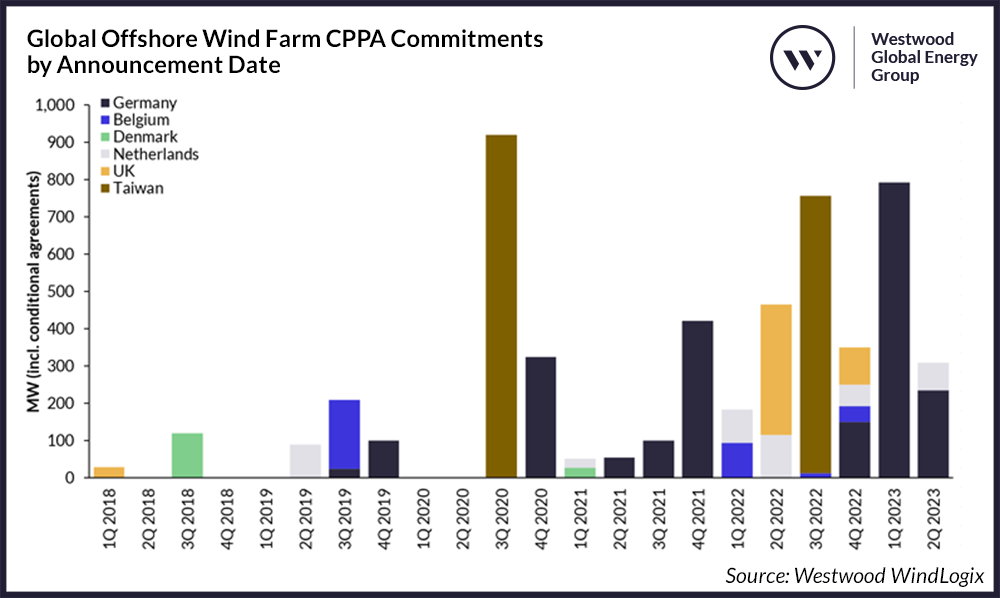This insight is excerpted from the executive summary of the latest in a series of thematic reports produced by Westwood and available to subscribers of WindLogix, as part of our enhanced coverage of commercial and investment themes in the offshore wind sector. In the report, we examine Corporate Power Purchase Agreements (CPPAs) in the offshore wind sector, their growing significance and the important intersection they represent between developers and corporates.
Enabling FID
CPPAs are playing a key role in enabling offshore wind final investment decisions (FIDs) in jurisdictions where zero-subsidy bidding has become common. The securing of long-term offtake (either from government or, as here, a corporate) plays a significant role in making a project bankable, which is usually necessary for it to move forward. Three types of CPPA-backed FIDs have been seen so far.
- The subsidy-free model, where 100% of the farm’s capacity is initially uncommitted and the developer will look to secure at least 50-60% from creditworthy offtakers to reach FID (e.g. Germany, Netherlands).
- The hybrid model, where part of the farm’s capacity is secured by government subsidy and part is secured by private offtakers (as seen in certain UK projects).
- The private model (currently speculative), where a CPPA enables FID outside of the ordinary subsidy regime, meaning the corporate can access power on its own timeframe.

Global Offshore Wind Farm CPPA Commitments by Announced Date
Source: Westwood WindLogix
Seller Beware
Despite the growing popularity of offshore wind CPPAs, it is worth bearing in mind that not every corporate consumer will be suited to offtaking power from offshore wind (compared to other renewables). Offshore wind developers are likely to require substantial minimum offtake volumes (precluding participations of smaller consumers) and long-term commitments made some years in advance of first power, which may exceed the time-horizons used by many companies in their strategic planning.
Such practical considerations effectively shrink the body of potential offtakers available for offshore wind versus smaller solar and onshore wind facilities – direct CPPAs via private wire are also unlikely to be feasible give the costs of offshore transmission. Slightly more sophisticated solutions, such as aggregated CPPAs split across a number of buyers in consortium, could however provide some support here.
It will be worth monitoring how the competitive landscape develops and the impacts this could have on the commercialisation of future offshore wind projects. Will more corporates enter the space and procure offshore wind power, or will the number of market participants stay static even if their demand grows? This would essentially strengthen the position of offtakers as the number of offshore wind farms lacking subsidy and looking to sell grows while the buyer pool remains consolidated.
Big Spender
The primary attraction of offshore wind for corporate offtakers is the sheer volume of power available from a single renewable source. Despite the challenges of contracting offshore wind power noted above, the sector has already proven popular in several industries (primarily heavy industry, energy intensive manufacturing and power-hungry tech operations) particularly in Europe.
The attraction of heavy industry to offshore wind power is obvious. Such companies consume large amounts of power, engage in long-term strategic planning and are large enough for their emissions profile to become a matter of public debate (thus providing a public relations benefit for decarbonisation). These sorts of consumers are also best placed to benefit from the price and volume hedging utility of tapping into a diverse portfolio of power providers.
So, CPPAs are clearly featuring increasingly prominently in the offshore wind industry, representing as they do the intersection between the needs of developers to find new forms of long-term offtake in a world of diminishing subsidy and the desire of corporate consumers to decarbonise their own operations. Going forward, industry players will be carefully monitoring how the use of CPPAs develops and the way that the commercial landscape changes as the offshore wind industry expands.
Peter Lloyd-Williams, Senior Commercial Analyst – Offshore Wind
[email protected]
For access to the full report, WindLogix and underlying data, please contact [email protected].




